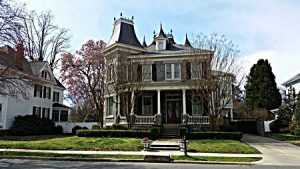From the Central Rappahannock Regional Library
A Different Story: A Black History of Fredericksburg, Stafford, and Spotsylvania, Virginia by Ruth Coder Fitzgerald.
These chapters are of particular interest: Chapter 2, Occupations and Owners (Antebellum period) and Chapter 13, Occupations (post-Civil War).
Economic Challenge and Mercantile Enterprise in a Southern Urban System: A Case Study of Fredericksburg, Virginia, 1835-1880 by Keith Edward Littlefield.
A doctoral dissertation written under the auspices of the University of Maryland, Graduate Studies in Geography. 380 pages.
Fifty Years of Service in the Printing Business, 1894-1944: Fiftieth Anniversary, May 10th, 1944 by Robert A. Kishpaugh.
Mr. Kishpaugh noted important local dates in the city's history in his 31-page book.
Four Mayors of Fredericksburg: An Oral History collected by Archer Williams.
Mayors Cowan, Rowe, Cann, and Davies recall the events of their administrations in 20th-century Fredericksburg.
Fredericksburg Business Directories
Fredericksburg Branch has the 1852 directory (photocopies) and the 1888-89 directory (combined with Alexandria). The 1892, 1910 (copied), and 1921 directories are also available. CRRL has a run of directories from 1938 to the present with the exceptions of 1957, 1960, 1963, and 1988 which are missing.
The Fredericksburg Fire of 1807 by Edward Alvey, Jr.
The 1807 fire destroyed six city blocks, including 45 homes, plus warehouses and stores.
The Fredericksburg Times.
This local magazine often featured articles by local historians. A separate index is available.
The Fredericksburg Wood Working Plant by Peter Pockriss.
Built in 1896 and shut down in 1904, the woodworking plant produced milled lumber and house trim for orders that were shipped as far as New York City and Boston. It was adjacent to the old Bridgewater Mills, near Amaret Street.
The Free Lance-Star Historical and Industrial Number: Portraying the Glorious Past and Future Possibilities of Fredericksburg, Virginia (1907) edited and compiled by Albert E. Walker.
This intriguing glimpse into Fredericksburg's industrial past is complete with photos. An index, compiled by Robert Hodge, is available separately.
Historic Fredericksburg by Oscar H. Darter.
A 55-page account, written in the 1950s, by a local historian and college professor. Each year, the University of Mary Washington's history department gives a scholarship in honor of Dr. Darter’s memory.
History of Fredericksburg, Virginia by Alvin T. Embrey.
A history written in the 1930s that includes biographical notes.
The History of the City of Fredericksburg, Virginia by S.J. Quinn.
This lengthy 1908 history is often affectionately referred to as "Quinn." Also available online.
The Journal of Fredericksburg History.
Historic Fredericksburg Foundation, Inc.'s annual, illustrated, and scholarly volume.
Oral History Index, 1997-1999 indexed by Ruth Coder Fitzgerald.
An index to Historic Fredericksburg Foundation's oral history project. Click here for a listing of titles.
Reference Materials for Historic Preservation 463 Laboratory in Museum Design and Interpretation compiled by John N. Pearce, Tad Czyzewski and Kathy J. Beard.
Contents:
The Industries of Fredericksburg, c1720-1996
Fredericksburg Business Data
City/Battlefield Industrial Park (Fredericksburg Industrial Park)
Fredericksburg Businesses: Major Employers
Fredericksburg: All Businesses, by Street
Documents relating to the creation of an exhibit with the working title, "Industrial Fredericksburg," at the Fredericksburg Area Museum and Cultural Center
Major headings from A History of Technology, Volumes III, IV, and V, and from Technology and Society in Twentieth-Century America
Sanborn Fire Insurance Maps
From the latter half of the nineteenth century through the first half of the twentieth, the Sanborn Insurance Company made detailed maps of many American cities, including the City of Fredericksburg, Virginia. The Sanborn Insurance Maps clearly document the growth of Fredericksburg and the changes to the city's buildings with regard to their shape, expansion or demolition, as well as their use.
Spotswood's Iron by Ralph C. Meima.
Alexander Spotswood's blast furnace was an important early step for industrialization in the Virginia Colony.
On the Web
1885 Business Directory
"Our Business Directory is as complete as we can make it for the present. It shows the organization of the city, the courts, the churches partially, the several societies, together with the date of their meetings, and also our active business men, individually, as firms."
"Embrey Work Uncovers History" - Free Lance-Star
A "colonial industrial park" was discovered lying beneath the waters of the Rappahannock which was likely active until a massive flood in the 1880s.
Fredericksburg's Battlefield Granite, opens a new window
The late 1800s and early 1900s saw the increase of locally quarried granite, called Battlefield Granite. The National Park Service's Noel Harrison discusses its history.
Fredericksburg Research Resources
City directories (1885, 1888-89, 1892, 1910-11, 1921, 1938), old codes and ordinances, indices to newspapers (1736-1928), manufacturing lists (1850 and 1860), lists of taxable town lots in Fredericksburg and Falmouth, Mutual Assurance policies (1796-1857), lists of claims for Civil War damage, some building specifications and contract documents, and plats of Fredericksburg (1721-1927).
The Fredericksburg Sassafras Distillery
"From April 1872 until 1874, Benjamin Deshields and William Burrell paid thirty cents per hundred pounds of Sassafras roots for the distillery they operated in the recently demolished building behind the present Community Center." Includes information on the plant's uses and characteristics.
The Fredericksburg Silk Mill
This article gives details of the silk mill's operation in the 1890s.
Hunter's Iron Works
An essay by local historian Jerrilyn Eby discusses the important Revolutionary War iron works near Falmouth.
Hunter's Island Vineyard
A quick discussion of the nearby vineyard that produced 3,000 gallons of wine in 1888.
The Story of the Rappahannock Canal
The canal, begun in 1829 and finished in 1849, carried timber, wheat, flour, corn, salt, fish, tar, and other products to the navigable portion of the Rappahannock River in Fredericksburg in the 1850s.
Walk through History: Mill Sites and Water Power
This walking tour, created by the Fredericksburg Area Tourism Department, introduces the history of the many mills that once flourished by the Rappahannock. Includes a map.




